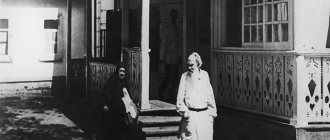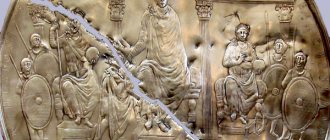Obsessed with the idea of world revolution, the Bolsheviks decided to renounce the old time in which Tsarist Russia lived and make it modern, European, and international. As stated in the decree, the transition to the Western calendar was made “in order to establish in Russia the same calculation of time with almost all cultural nations”... The Soviet country, having gone to sleep on January 31, 1918, was supposed to wake up on February 14. Now time coincided with the Gregorian calendar, which was used by Catholics. But these changes did not affect the Russian Orthodox Church: it continued to celebrate its holidays according to the old Julian calendar.
We talk about the “13 lost days” metaphor with Andrei Sorokin, director of the Russian State Archive of Socio-Political History, where all the decrees signed by the leader of the revolution are stored.
13 lost days. How to evaluate them: how did Bolshevik voluntarism take and cut out a piece of history, literally and figuratively? Or was it a positive impulse towards a common culture with Europe?
Andrey Sorokin:
The leaders of the Bolshevik Party and the Council of People's Commissars had completely understandable and utilitarian goals. The Russian revolution was interpreted by Lenin as a prologue to the world revolution. The hearts of proletarians all over the world had to beat in unison and according to one chronometer. So it is not surprising that this decree was among the first to be adopted. And, of course, he expressed the real needs of political life and economics. But we must remember that this is one of hundreds of decrees that were adopted by the Bolsheviks in the first months after coming to power.
But you must admit, it was also a rather transparent gesture: to kill the old time in which tsarist Russia lived. The Red Country loved symbolism.
Andrey Sorokin:
In this sense, the Bolsheviks had a limited arsenal. All their romance and symbolism is associated with the rejection of the old world. And not just with refusal, but with the conscious destruction of the foundations of the old world order, no matter what it concerns. In many of Lenin’s works and his political documents we will find specific guidelines that orient the Bolshevik Party and the new regime towards the destruction of the old statehood, the old traditional culture, old customs, traditions and norms of formal and common law. And, of course, the decree we are talking about fits completely into this course, into this worldview. Therefore, the rejection of the old chronology was truly perceived by many as a symbolic gesture demonstrating the pathos of building a new world, I emphasize - not independently, but together, in alliance with the proletarians of the whole world, primarily of developed European countries.
It was also a step against the church, a negative pass towards Orthodoxy. It turned out that the new secular calendar coincides with the Catholic church calendar. But the Russian Orthodox Church continued to live as before, lagging behind in time...
Andrey Sorokin:
I think that these considerations were on the periphery of the Bolshevik consciousness. The means of combating the “religious dope” were different and much more severe. Their set is known.
Can this decree of Lenin be called one of the most powerful post-revolutionary globalist projects?
Andrey Sorokin:
Don't think. Other decrees were fundamental. For example, “About the world” and “About the earth”. They made it possible to almost instantly win the sympathy of a huge number of citizens of the Russian Republic and other states.
It was the first decrees of the Soviet government, not only those that I mentioned, but also a number of others, that were understandable to the masses and helped the Bolsheviks win the Civil War. And she, in turn, spread the influence of the ideas of the revolution and Bolshevik practices throughout the world.
The Bolsheviks were one of the first to adopt the Decree on Time. Photo: Publishing project of Vladimir Lisin “Days of 1917 100 years ago”
details
Introduction of the Gregorian calendar to the USSR
Pope Gregory XIII
Peter's reform of 1700, which changed the beginning of the chronology - from the Nativity of Christ (and not from the Creation of the world) - nevertheless left the Julian calendar in force. In addition to its harmonious and spiritual superiority over the Gregorian, it served as some additional barrier to the merger of Russia with the Western Christian-apostasic world.
However, already in the 19th century, in trade and political relations with foreign countries, part of Russian society and officials began to succumb to the “pan-European norm” of the Gregorian calendar; The new style, along with the old one, began to be used in international relations and in business correspondence of relevant departments.
In 1830, the St. Petersburg Academy of Sciences came up with a proposal to introduce a new style in Russia in order to facilitate relations with cultural Europe. The then Minister of Public Education, Prince K.A. Lieven, in his report to Sovereign Nicholas I, assessed the proposed calendar reform as “unnecessary, which could produce unwanted unrest and confusion of minds... the benefits from changing the calendar are very unimportant, almost negligible, and the inconveniences and difficulties are inevitable and great.” The Emperor wrote on the report: “Prince Lieven’s comments are completely fair.”
and his coat of arms on the floor of the Roman Cathedral of St. Petra
But the “progressive” scientific and bureaucratic community cared about calendar “accuracy” and did not abandon attempts to calendar unity with the West. In 1899, a commission was created at the Russian Astronomical Society for this purpose, consisting of representatives of many scientific institutions and government departments. Fortunately, the opposition of conservative forces in the government and the Holy Synod of the Russian Orthodox Church did not allow the Commission to carry out its plans.
The Imperial Academy of Sciences continued to push for reform and created its own calendar commission. The Emperor allowed its activities, but ordered that the considerations of the former minister, Prince Lieven, be taken into account. The wise Chief Prosecutor of the Holy Synod K.P. Pobedonostsev opposed this idea even more decisively and buried it. Metropolitan Anthony Vadkovsky concluded: “ The Julian calendar, when applied to church practice, in all cases is a reliable anchor that keeps the Orthodox from being completely absorbed by the heterodox world, it is like a banner under which the children of Orthodoxy gather together
».
Immediately after the October Revolution, at one of the first meetings of the Council of People's Commissars on November 16 (29), 1917, the Bolsheviks decided to replace the “obscurantist-Black Hundred” calendar with a “progressive” one. The decree “On the introduction of the Western European calendar in the Russian Republic” was adopted at a government meeting on January 24 (February 6), 1918 and signed by Lenin - “in order to establish in Russia the same time calculation with almost all cultural nations.” The decree prescribed that the next day after January 31, 1918 should be considered not the 1st, but the 14th of February, etc. And for the transition period until July 1, 1918, it was allowed to put the old style in brackets after the date according to the new style.
The Orthodox Churches maintained unity in the fight against calendar reform until 1923. The decision to switch to a new style was made at a meeting in Constantinople, convened in 1923 by the “progressive” Patriarch Meletius, who was a Freemason (this is noted in the Masonic Encyclopedia). The Russian, Bulgarian, Serbian and Jerusalem Churches were absent from the meeting. A compromise version of the Gregorian calendar was proposed as a new calendar - the so-called “New Julian” calendar, proposed by the Yugoslav astronomer M. Milankovic. In it, as in the Gregorian calendar, the periodicity of the change of simple and leap years is also disrupted, and until 2800 both calendars completely coincide. At the same time, the Churches that adopted the New Julian calendar, as a compromise, retained the Paschalia based on the Julian calendar; Immutable holidays began to be celebrated according to Gregorian dates.
It must be admitted that such a compromise calendar makes it easier for Christians to live in outward harmony with the surrounding non-Christian world, but it introduces disruption into liturgical life and entails a violation of the Church’s regulations on holidays and fasts. Thus, in some years (during late Easter) the Apostolic Fast is significantly reduced, or even disappears altogether; sometimes it falls on days prohibited for fasting in liturgical practice. As in the Gregorian calendar, the days of remembrance of saints, and therefore the days of the Angel of Orthodox Christians, have completely changed
. The introduction of the new calendar caused great confusion and schism in Orthodox countries, dividing Christians into “Old Calendarists” and “New Calendarists,” thus becoming a serious Masonic blow to the Church.
The Russian Orthodox Church still preserves the former harmonious Orthodox calendar. An attempt in 1923 to switch to a new church calendar was unsuccessful: popular protests prompted Patriarch Tikhon to abandon the innovation imposed by the Renovationists and Bolsheviks.
To this day, the Julian calendar, associated with the decisions of the Ecumenical Council on the celebration of Easter, has been preserved in the world only by the Russian, Jerusalem, Georgian and Serbian Churches, Athos monasteries, some Russian parishes of the Orthodox Church in America, as well as groups of so-called Old Calendarists in Greece (after the schism for this reason in 1923), the Bulgarian and Romanian Local Churches.
Let's finish this note with the words of Professor V.V. Bolotov, which he said in 1899 at the aforementioned calendar commission: “ I think that the cultural mission of Russia is to keep the Julian calendar in life for several more centuries and thereby make it easier for Western peoples to return to the unspoiled old style
"(see: Priest K. Bufeev. On the advisability of Russia’s transition to the old calendar style. 1998).
Permanent page address:
Leave your comment
« Previous entry
Reforms we avoided
In 1939, the “Union of Militant Atheists” took the initiative to assign other names to the generally accepted names of the months. It was proposed to call them like this:
| Regular | Suggested |
| January | month of Lenin |
| February | month of Marx |
| March | month of the Revolution |
| April | month of Sverdlov |
| May | the month of May |
| June | month of the Soviet Constitution |
| July | month of harvest |
| August | month of peace |
| September | month of the Comintern |
| October | Engels month |
| november | month of the Great Revolution |
| December | month of Stalin |
However, sensible heads were found, and the reform was rejected. You may be interested in: Israeli calendar
Japanese calendar
You can order calendar printing on our website in the Calendar Printing
Fyodor Viktorovich Vinberg, officer, Black Hundred member, writer and publisher (in exile) died
Discussion: 15 comments
- Irina:
12/14/2010 at 00:00To switch from a new style to an old one, you need to subtract 13 days from the date according to the new style. According to the Gregorian calendar (new style), the New Year begins on January 1. And according to what style is the Old New Year celebrated on January 14? After all, according to the old style (Julian calendar), it should be celebrated 13 days earlier, not later, i.e. December 19, not January 14.
- * * *:
12/14/2010 at 00:00
Irina, we must not subtract, but add 13 days to the old style: 1+ 13 = 14.
- Chur:
05/27/2012 at 00:00
Simple question: What calendar was there in Rus' in the Summer from SMZH 6496 (988) and before that. If possible, then indicating the sources of information.
- Adm. — Churu:
05/27/2012 at 00:00
See the article about the calendar: https://rusidea.org/25011403
- Georgy:
11/24/2015 at 00:00
Where are the sources? It is unclear what the author relies on when concluding that popular protests prompted Patriarch Tikhon to abandon the innovation imposed by the renovationists and Bolsheviks. Where it is convenient to have intelligible argumentation. And what kind of source is this Masonic encyclopedia?!
- Warrior:
03/30/2016 at 00:00
Thanks for the great article.
- Georges:
01/13/2017 at 00:00
Irina, repeat the arithmetic for 2nd grade
- AVTANDIL:
01/16/2017 at 00:00
Anyone who demands to indicate the source is very disingenuous; Lenin and K* were also disingenuous when they introduced the Western style of life as the basis for the transformation of the Russian people into a cultural nation as part of the West. Elementary - the calendar they canceled was distinguished by the mathematical accuracy of the world cosmos it reflected (including the Earth as an element of the Cosmos). In this regard, Russia is experiencing inaccuracies in development, both materially and spiritually. It was only possible to kill the Romanov family so cruelly and horribly in a non-Russian, Western style. Changing the calendar is the murder of everything Russian - both living and dead. Correct the countdown of universal events (return everything to normal) and RUSSIA’S THINGS WILL GET GOOD!!!!!!
- Anna:
01/30/2017 at 00:00
Tell me, how is it that Lenin moved the calendar forward by two weeks, and we “celebrate” the New Year according to the “old style” also two weeks after the New Year according to the new style????? Isn’t it more logical that New Year’s Eve according to the old style was November 18 + 14 days = January 1??? Or as they say, “the skis don’t work.” Can anyone clarify??
- Adm. — Anna:
01/30/2017 at 00:00
We celebrate New Year according to the old style on January 1st. = 14 Jan n.st. What's unclear here? The difference is 13 days. Where did you get November 18 + 14 days = January 1??
- Victor:
02/17/2017 at 00:00
In the USSR(?) a new calendar style(?) was introduced in 1918. With all the will, the USSR was created only in 1922, on December 30!!!
- MVN - to Viktor:
02/18/2017 at 00:00
You're right. Corrected to "Bolsheviks". Fortunately, their attempt to replace the Cyrillic alphabet with the Latin alphabet failed. But you don't seem happy about this?
- Oleg:
12/24/2017 at 07:58
Russia switched to the Gregorian calendar under the Bolsheviks. At that time, the church was under persecution, and it was to Lenin’s advantage (and not a bad one, after all) that the people, having spent the New Year partying and getting drunk, would no longer be able to walk any further. For the New Year, this miracle was invented - Santa Claus, who began to perform miracles. Everything is very simple. Over 150 years, the Julian calendar lags behind world time by 1 day, so in 50 years, according to the Julian calendar, Christmas will be on January 8.
- MVN:
12/24/2017 at 08:44
Oleg, Christmas is always celebrated according to the Julian calendar on December 25th. And according to the Gregorian calendar too, with the corresponding calendar difference. See about this% https://rusidea.org/25011403
- Victor:
10/01/2018 at 22:50
14th comment: not January 25, but December 25, could you suggest literature on the calendar topic (comparison of the JULIAN and GREGORIAN calendars)?
[Thank you. The typo has been corrected. Comparison of calendars, see: https://rusidea.org/25011403 ]
Similar stories
A similar story happened in America and England in the 18th century, but then the difference between the year calculation systems was smaller, and the British and Americans “lost” only 11 days.
So, 260 years ago, Americans “lost” the date of September 13, 1752, as well as the previous ten days - people went to bed on the evening of September 2, and woke up on the morning of the 14th.
The 11 days between these dates were simply skipped - this was done by order of Parliament, which decided to introduce the Gregorian calendar in order to equalize Britain and its overseas possessions with most of Western Europe.
By the way, China switched to the Gregorian calendar only in 1949. Some other countries a little earlier: Egypt in 1928, Turkey in 1926, Greece in 1924, Romania and Yugoslavia in 1919.






